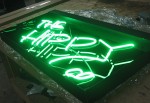“I built a sign for them that says ‘no vacancy’ and then, when some of the letters blink off, it says ‘vacay,’” Farrell laughs.
Wellington is about as far as he wants to reach, however.
“I don’t deal with long-distance shipping anymore, so all of my clients are local,” he says, explaining his marketing focus is on the Greater Toronto Area (GTA) and surrounding communities within Ontario, but no longer Canada-wide.
 A craft without competition
A craft without competition
All of Hope Neon’s jobs today are one-offs, allowing Farrell to focus on each as it comes through his shop.
“Every day is so different now,” he says. “Sometimes I’m doing a site check. Other days, I’m in the shop working on layouts and blowing glass. And I have no set hours, whereas before the shop was like a factory. I love it. I don’t make as much money as I used to, but I totally enjoy it now.”
Clients continue to find him through word of mouth, partly because Hope Neon has been in business for so long, but also because neon artists like Farrell—who now has 30 years’ experience—have become very rare, so he faces little competition within his niche market.
“There’s only a few of us left now and I still have a good reputation,” he says. “I can do everything from design to glass-blowing to electrical installation myself, whereas other companies don’t go right from beginning to end.”
So, while the sign industry at large has benefited from a major shift toward LEDs as a standard illumination technology, Hope Neon succeeds by staying more or less the same.
“The hand-crafted art of glass bending and the equipment haven’t changed much over the years,” Farrell says. “There have been some changes in the neon gas process equipment, glass colours and layout design by computer, but overall, a neon shop in the present isn’t much different from one in the past. I wonder if Rudy would have bet his start-up, one-man shop would still be producing neon signs more than 50 years later?”





